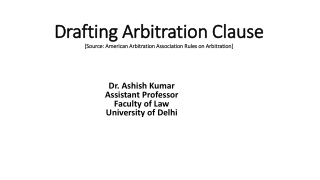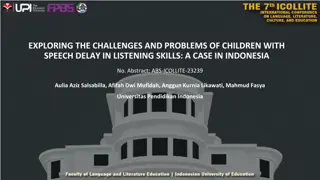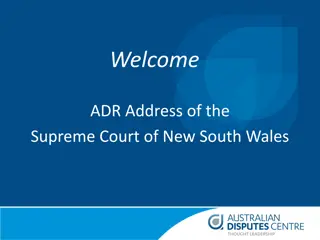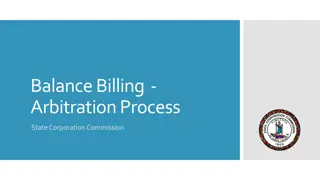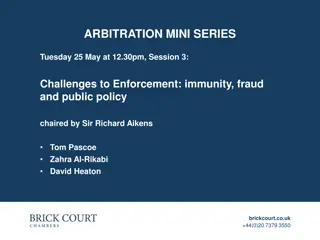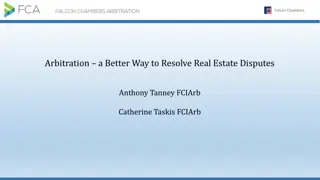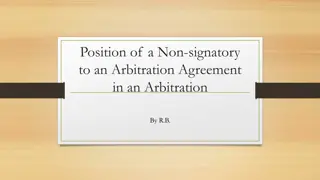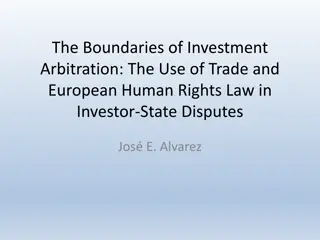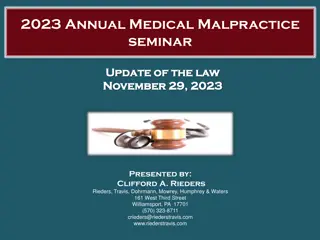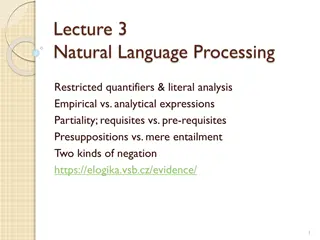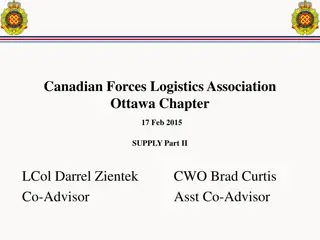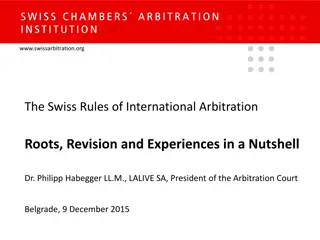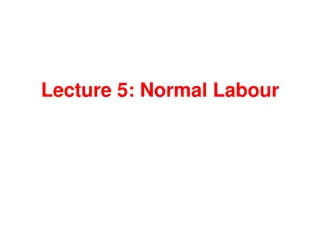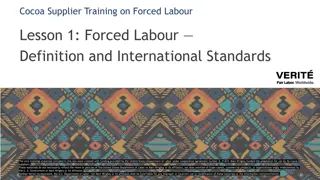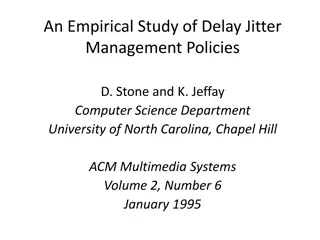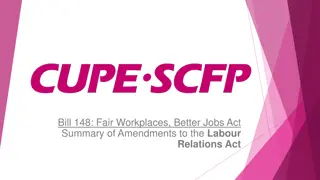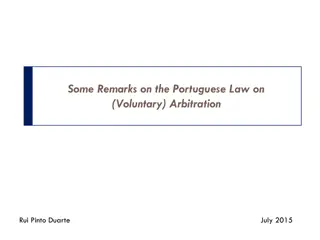Delay in Canadian Labour Arbitration: An Empirical Study
Research explores the increase in delay from grievance initiation to arbitration awards in Canadian labour relations, discussing causes and implications. Factors include exogenous demands, party preferences, and service supply issues.
Download Presentation

Please find below an Image/Link to download the presentation.
The content on the website is provided AS IS for your information and personal use only. It may not be sold, licensed, or shared on other websites without obtaining consent from the author.If you encounter any issues during the download, it is possible that the publisher has removed the file from their server.
You are allowed to download the files provided on this website for personal or commercial use, subject to the condition that they are used lawfully. All files are the property of their respective owners.
The content on the website is provided AS IS for your information and personal use only. It may not be sold, licensed, or shared on other websites without obtaining consent from the author.
E N D
Presentation Transcript
Labour Rights Arbitration: An Empirical Investigation of Delay in a Changed Legal Environment June 6, 2019 Canadian Industrial Relations Association Annual Meeting Professors Kevin Banks, Richard Chaykowski and George Slotsve Centre for Law in the Contemporary Workplace Queen s University
The Problem Research demonstrates a steady increase between the 1970s and early 2000s in the average time from initiating a grievance to the rendering of an arbitration award in all Canadian jurisdictions studied. Delay in labour arbitration can: harm contract negotiations, cause financial loss to the employer, harm the quality of the arbitration hearing itself as memories fade, inhibit productivity by generating both employee restiveness and uncertainty among supervisors, and impose injustice on employees whose rights under collective agreements are less likely to be fully vindicated.
Theorizing the Causes Rights arbitration is a form of private dispute resolution provided through a competitive market In principle the parties should be able to control the process so as to ensure its efficiency. But the market for dispute resolution services may be subject to exogenous constraints and endogenously produced failures.
Theorizing the Causes: 4 Types of Constraint or Market Failure (1) Exogenous demands and constraints on the institution of arbitration (2) Preferences of parties for matters other than efficiency; (3) A shortage in the supply of expeditious arbitration services; (4) Cost, incentive or coordination problems facing the parties.
1. Exogenous Demands and Constraints 1. Increased frequency of complex disputes due to the expansion of jurisdiction 2. Increased litigation of the scope of jurisdiction 3. Culture of legalism
2. Endogenous Demand Factors: Party Preferences 1. Control: minimizing the risk of unpredictable outcomes 2. Greater value placed on perceived fairness or correctness 3. Allowing time for public sector decision-making processes 4. Allowing time for healing 5. Preference for prior mediation
3. Short Supply of Expeditious Dispute Resolution Services 1. Hypothesis that leading arbitrators are often too busy to write awards in a timely manner, while less experienced but more available arbitrators often lack the skills and experience required by the parties. 2. One study found arbitrators that are trained lawyers are associated with delay and suggested that this was due to a tendency towards increased legalism on their part.
4. Coordination, Cost, or Incentive Problems 1. Lack of information 2. Transaction costs 3. Risk of Defection 4. Up-front Costs 5. Incentive Problems
Data Coded very publicly reported arbitration decision in Ontario in 2010: 648 decisions. Consent awards and interim awards excluded. Dependent variables: Event to First Hearing Time; Grievance to First Hearing Time; Hearing Days; Hearing Time; Award Time
Data Independent variables: (1) Legal subject matter (2) Whether arbitrator decided a contested issue of fact (3) Proxy for busy arbitrator (4) Type of arbitration board (sole arbitrator or three person panel); (5) Whether the employer or union was represented by counsel.
Data Controls: 1. Economic sector of the employer (government, health care and education, other) 2. Whether the parties invoked expedited arbitration or mediation under the Labour Relations Act, 1995 3. Gender of the grievor 4. Gender of the arbitrator. 5. Whether the parties used an agreed statement of fact.
Approach to Regression Analysis Estimate formal hazard models. The hazard function is, for example, the probability that a grievance for which the hearing has been concluded for x days will have an award rendered in the near future. Where the covariates thought to influence the duration in a state and the exit rate, proportional hazard specification was used.
Profile of Cases 54% in the broader public sector 95% of the cases were decided by a sole arbitrator Statutory expedited arbitration used only about 6.9% of the time Statutory mediation-arbitration procedures only about 1.3% of the time Agreed statement of fact in only about 13% of cases.
Profile of Cases The employer (at about 79%) was more likely to be represented by counsel than the union (at roughly 63%). The average number of lawyer representatives in our study (1.42) is very similar to that recorded by Curran for the year 2012 (1.47).
Profile of Cases Most frequently decided issues: Finding of fact on a disputed matter in about 37% of the cases. Wages or Related Benefits (21%), Discharge for Discipline (20%), Assignment or Scheduling of Work (17%). Human Rights or Other Discrimination (9%), Jurisdiction (7%) Matter of Procedure (7%). Non-Human Rights Legislation (5%), Benefit or Welfare Plan (whether insured or not) (5%) Frequency of issues in our study is somewhat lower than that of comparable issues recorded in Curran s (2017) paper. This likely reflects our decision to code for issues decided rather than to code by content analysis.
Time Lapses Median durations: Event to first hearing: 215 days Grievance to first hearing: 275.5 days First to last hearing: 1 day (0 days elapsed between these two points in time) First hearing to award: 48 days Last hearing to award: 26 days Event to final award: 345 days Grievance to final award: 380 days. The number of hearing days ranged from 0 to 24 days, with 50% taking only 1 (or no) day(s), about 68% of cases requiring 2 or fewer hearing days, and 95% taking 8 or fewer days.
Regression Results: Prehearing and Total Time Table 5: Regression Results for Event to First Hearing and Event to Final Award Event to First Hearing (efdur) Generalized gamma regression Event to Final Award (eadur) Loglogistic regression Robust Std Error Robust Std Error Variable Coefficient P>|z| Coefficient P>|z| Government Tripartite Section 49 Section 50 Busy Arbitrator Procedure Pension Plan CBA interpretation Disc. discharge Discipline Assignment Wages Word count .5446673* 1.619008* -1.144759* .1373517 .3792891 .1761919 0.000 0.000 0.000 .583792* 1.375118* -.7796332* -.2790461* .0189016* -.3947002* -.9372596 .5166088* -.6142832* -.4583259* -.2761233* -.3955488* .0000947* .1322155 .2966958 .2620868 .163594 .0113578 .1809825 .2995209 .2672921 .1663575 .1782109 .1620521 .1783907 .0000184 0.000 0.000 0.003 0.088 0.096 0.029 0.002 0.053 0.000 0.010 0.088 0.027 0.000 .0284522 .0115671 0.014 -.9071809* -.5574363* .187348 .2122712 0.000 0.009 -.3404566 .0000414* .1799957 .0000201 0.059 0.040
Regression Results: Hearing Time First to Last Hearing - Hearing Time Lognormal regression Robust Std Error Variable Coefficient P>|z| Government Union counsel Counsel interaction Agreed statement Jurisdiction Disputed facts Charter Benefit/welfare plan Wages Word Count .7892528* .7119005* -.5050607* -.9609099* -1.005652* .718098* 2.013128* -1.038171* -.8808779* -6.40e-09* .3213317 .241852 .3280869 .4108134 .1092766 .5275058 .5448208 .823903 .6115212 .0000436 0.014 0.030 0.055 0.001 0.045 0.010 0.051 0.043 0.031 0.000
Regression Results: Hearing Days Hearing Days (ndays)(ldate) Generalized gamma regression Robust Std Error .047444 .0404635 .0379779 .0854669 .1961076 .0951159 .0388015 .1070784 .3487108 .1242407 .0964462 .1258284 .1127434 .0793592 .0773787 .0995356 .0000102 Variable Coefficient P>|z| Government Education Agreed statement Jurisdiction Admissibility Produre Disputed factrs Human rights Charter Pension plan Benefit/welfare plan Non-HR legislation Discipline Assignment Wages Non-disc termination Word count .1408479* .1065397* -.166312* -.2198872* -.4477006* -.2517229* .1339808* -.2979273* .8843422* -.2192395* -.1953321* -.210195* -.2475719* -.2101365* -.2061396* -.1787502* .0000468* 0.003 0.008 0.000 0.010 0.022 0.008 0.001 0.005 0.011 0.078 0.043 0.095 0.028 0.008 0.008 0.073 0.000
Regression Results: Award Time Final Hearing to Final Award - Award Time (ladur)(adate) Generalized gamma regression Variable Coefficient Robust Std Error P>|z| Government Counsel interaction Section 50 Agreed statement of fact Busy arbitrator Disputed facts Benefit/welfare plan Word count Arbitrator gender .3312499* -.4536643* -.9167097* .2822277* -.0243259* .3259059* -.6500781* .0001825* -.2050394* .1547408 .1977725 .3060811 .1339538 .0111504 .1328653 .354564 .0000346 .1198036 0.032 0.022 0.003 0.035 0.029 0.014 0.067 0.000 0.087
No evidence that changed legal environment is causing delay No evidence that the number or type of jurisdictional or substantive legal issues in the labour arbitration system increased the length of time required to complete any stage of the arbitration process. The only subject consistently resulting in longer times was the Charter of Rights and Freedoms. But it arises very infrequently and could not account for any increase in delay throughout the system. This indicates that the novelty or complexity of additions to arbitral jurisdiction has not caused increasing delay. Our results in this regard are consistent with the descriptive findings of Curran (2017).
Only modest support for the theory that a culture of legalism is increasing delay No significant evidence that deciding procedural, evidentiary or jurisdictional issues at arbitration causes delay. Length of arbitral awards had no substantial effect on delay. On the other hand, use of lawyers prolongs the time from first hearing to final award. This suggests that the way that lawyers present cases takes longer than the way that non-lawyers present cases, or that the submissions of lawyers take arbitrators longer to deal with in writing decisions, or both. But the vast majority of delay occurs prior to the hearing. A culture of legalism cannot account for this on its own.
Party preferences probably do not account for growing delay account for a relatively small fraction of total delay, since most of it occurs prior to the hearing. Any preference for procedural formality at the hearing could only hearing. The busyness of the arbitrator had only a small effect on time to first decision-making with respect to grievances, it is unlikely that they would require the time available under current delays, under which the median case takes over a year to complete. Even if public sector employers and unions required more time for would be beneficial (cases involving unjust discipline or human rights cases, for example) and additional delay. No association between the types of cases in which time for healing
Party preferences probably do not account for growing delay The growing preference for mediation-arbitration may be contributing to delays, but: - mediation-arbitration was probably used in only a relatively small fraction of cases (Curran finds that mediation-arbitration is used in only about 20% of cases in 2012); - the tendency towards increased delay predates the increased use of med-arb by at least two decades.
No evidence that limited supply of experienced arbitrators is a primary cause of increased delay If this were the case, the use of busy arbitrators would be associated with much more delay at the prehearing stage than it is.
Conclusions: Where the Problem Isnt, and Where it Probably Is The determinants of increased delay in arbitration lie not in the changed legal environment, the preferences of parties with respect to procedures or representation, or the supply of arbitration services but rather in incentive, cost or coordination problems facing the parties, most particularly in prompt scheduling of first hearings.
Some Cost, Coordination and Incentive Issues Probably Don t Matter that Much 1. Information about expedited systems 2. Risk of defection from agreements to expedite 3. Tactical delay
The Most Critical Diagnosis and agency problems as the most likely primary and systemic factors contributing to delay in arbitration in Ontario. This leaves upfront costs due to accumulated backlogs, constraints, and the incentive structures of employer and union representatives (whether counsel or not) facing backlogs that may be the most important root causes of delay in labour arbitration. It is the habituation of parties to delay, their resource
Policy Implications Addressing the bulk of increasing delay probably does not require: Changes to arbitral jurisdiction Regulation of arbitral decision-making time lines. A larger supply of arbitrators. Moving away from legal representation.
Policy Implications Ultimately, it is up to the parties to instruct and incentivize their representatives to undertake the prehearing preparation and cooperation to identify possibilities for settlement, and in the event that settlement is not possible, to enable efficient and proportional presentation of evidence.
Policy Implications Ministries of Labour could: Assist parties, through information resources and mediation services, to put temporary or permanent expedited dispute settlement systems in place to help clear backlogs and prevent their recurrence; Make information and training in expedited or proportional presentation of evidence available to the parties and to arbitrators, and support the creation of a culture of proportionality; and Support or conduct research into the effects of mediation-arbitration on timeliness.


